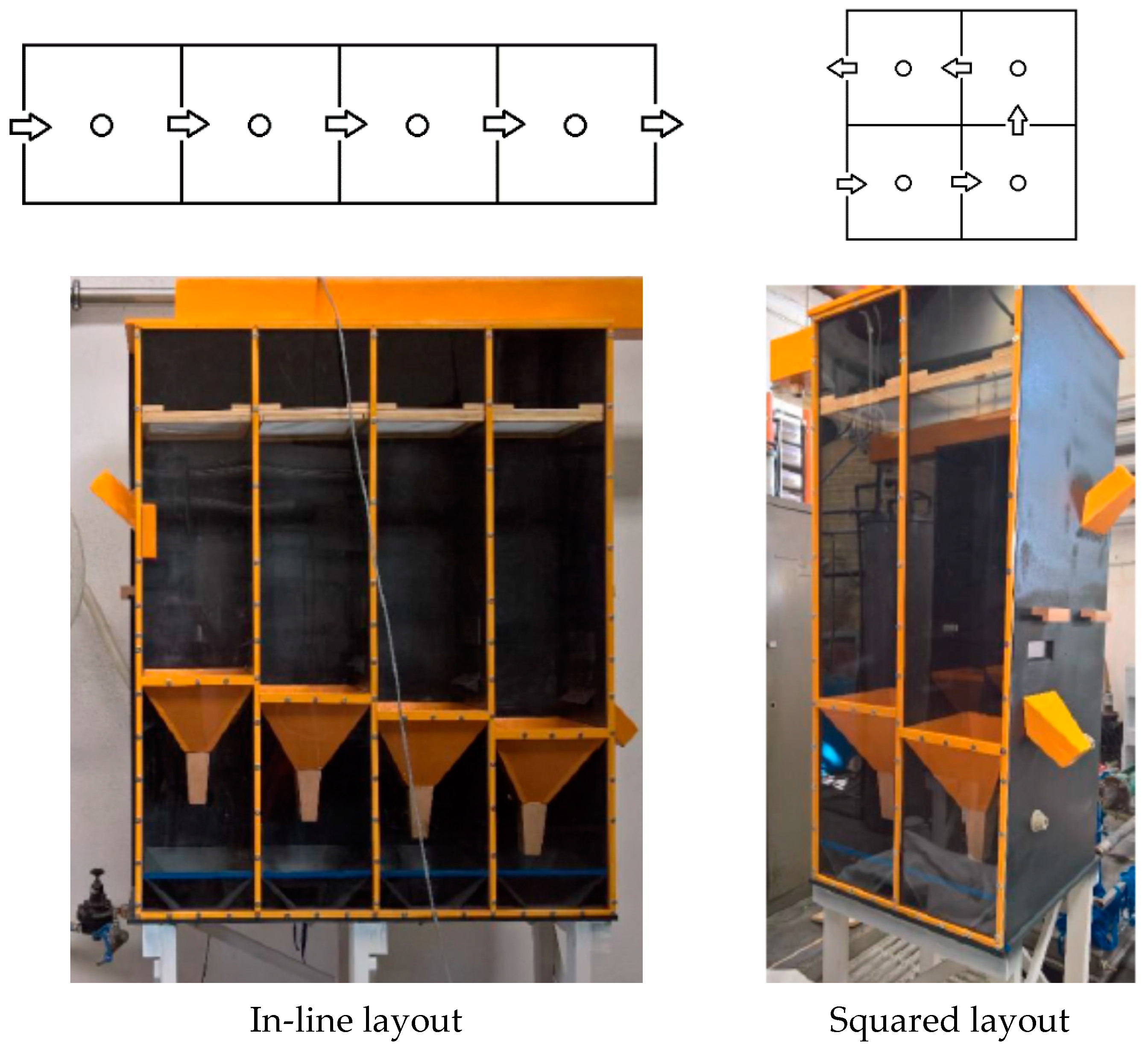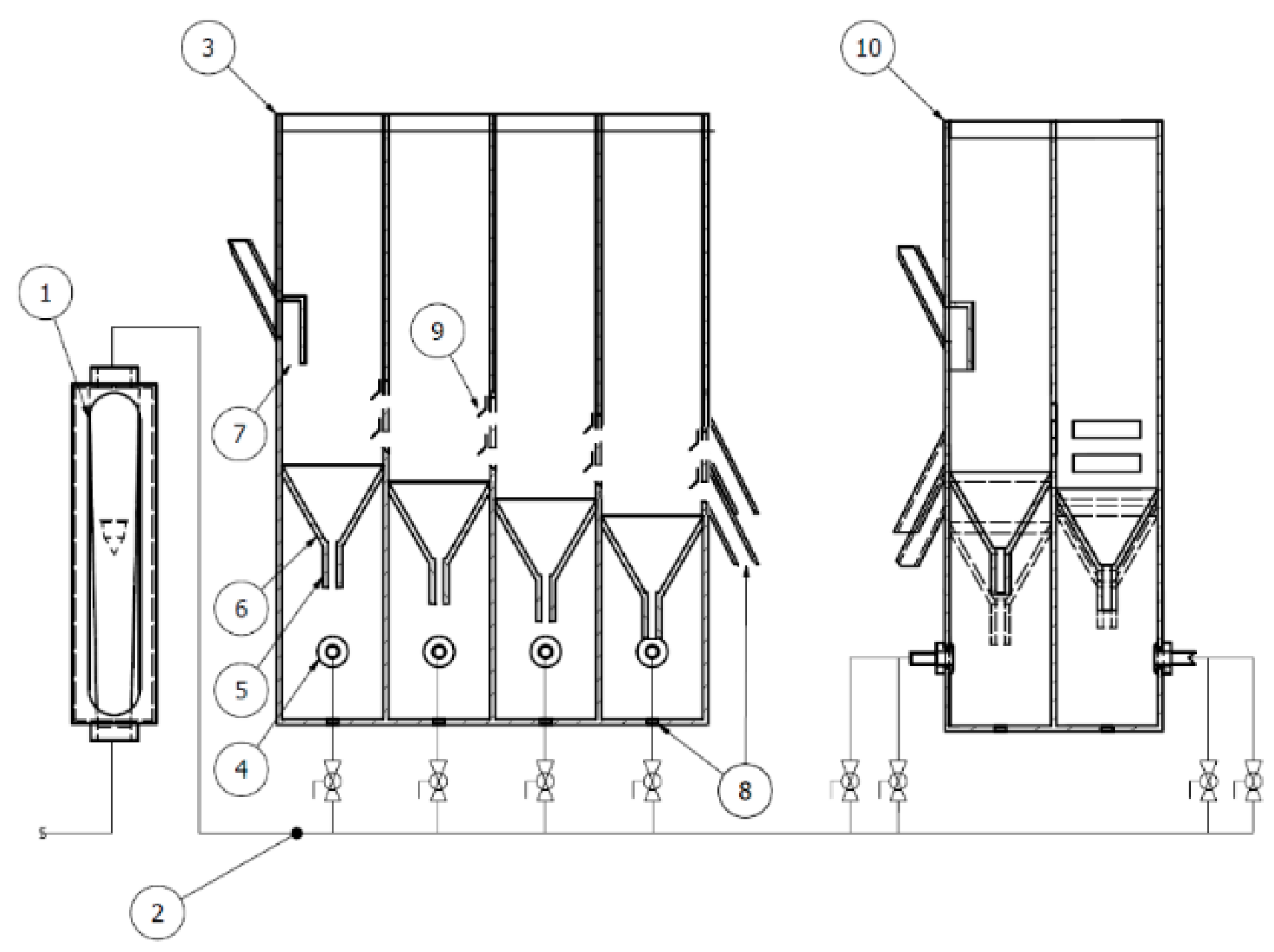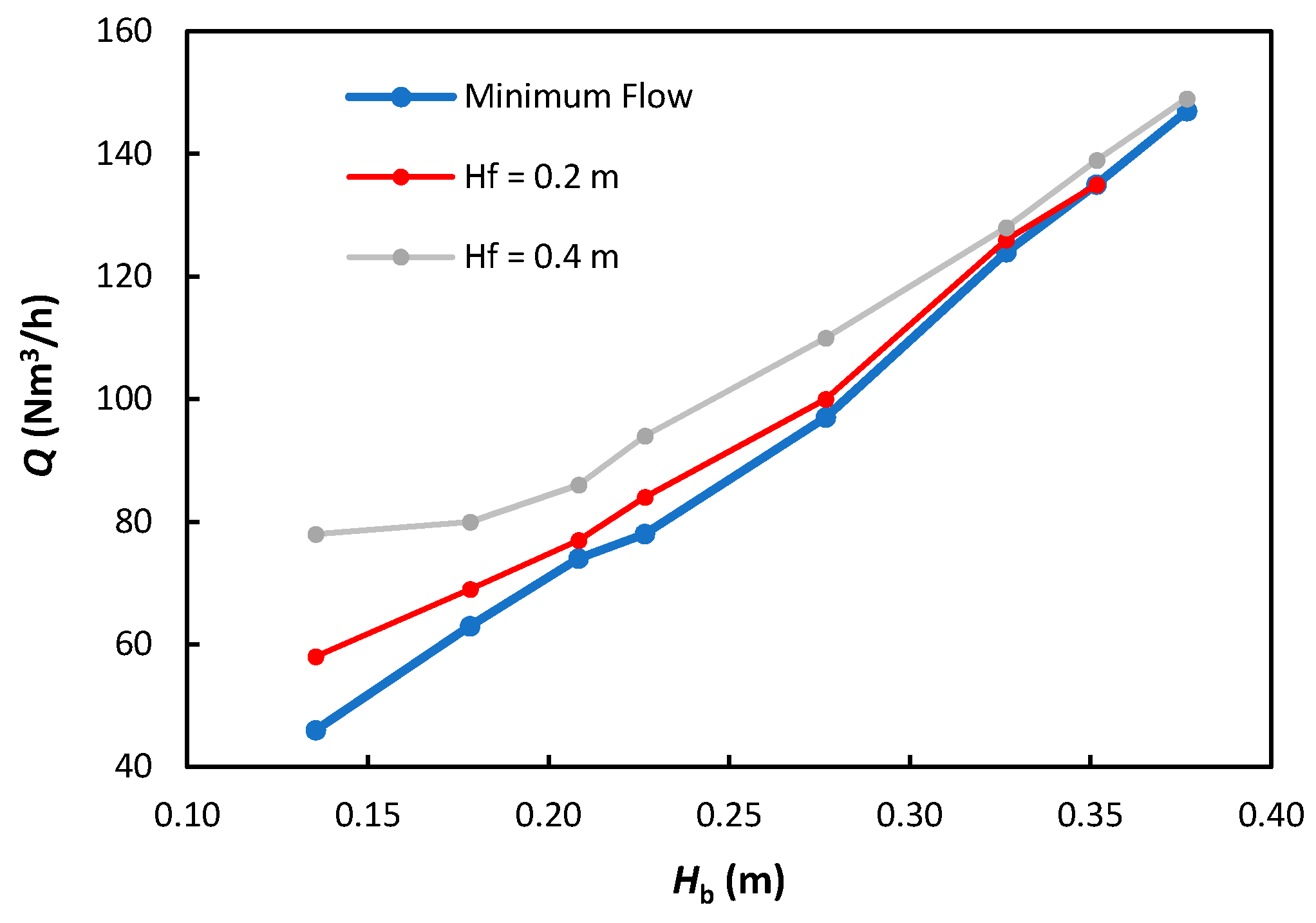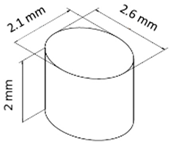Experimental Study on the Solids Residence Time Distribution in Multiple Square-Based Spouted Beds
Abstract
1. Introduction
2. Materials and Methods
2.1. Experimental Set-Up
2.2. Particle Properties
2.3. The RTD Functions
2.4. The Experimental Procedure
- Ci: concentration of black tracer in the i-th sample (kg/m3);
- Mtr,i: mass of black tracer in the i-th sample (kg);
- Mtot: mass of black tracer introduced in the reactor (kg);
- ρrel: bulk density (kg/m3);
- : mass flow rate of white PET (kg/s).
3. Results and Discussion
3.1. Preliminary Fluid Dynamic Tests
3.2. Influence of Bed Height on a Single Dynamic Unit
3.3. Influence of the Number of Units
3.4. Final Comments
4. Conclusions
Author Contributions
Funding
Conflicts of Interest
References
- Epstein, N.; Grace, J.R. Spouted and Spout-Fluid Beds; Epstein, N., Grace, J.R., Eds.; Cambridge University Press: Cambridge, UK, 2010; ISBN 9780511777936. [Google Scholar]
- Marshall, D.W. Spouted bed design considerations for coated nuclear fuel particles. Powder Technol. 2017. [Google Scholar] [CrossRef]
- de Freitas, L.A.P. Pharmaceutical applications of spouted beds: A review on solid dosage forms. Particuology 2018. [Google Scholar] [CrossRef]
- Olazar, M.; San José, M.J.; Zabala, G.; Bilbao, J. New reactor in jet spouted bed regime for catalytic polymerizations. Chem. Eng. Sci. 1994, 49, 4579–4588. [Google Scholar] [CrossRef]
- Mollick, P.K.; Venugopalan, R.; Roy, M.; Rao, P.T.; Sathiyamoorthy, D.; Sengupta, P.; Sharma, G.; Basak, C.B.; Chakravartty, J.K. Deposition of diversely textured buffer pyrolytic carbon layer in TRISO coated particle by controlled manipulation of spouted bed hydrodynamics. Chem. Eng. Sci. 2015, 128, 44–53. [Google Scholar] [CrossRef]
- Massaro Sousa, L.; Ferreira, M.C. On the performance of a spouted bed type device for feeding spent coffee grounds to a circulating fluidized bed reactor. Chem. Eng. Res. Des. 2020, 160, 31–38. [Google Scholar] [CrossRef]
- Cundall, P.A.; Strack, O.D.L. A discrete numerical model for granular assemblies. Géotechnique 1979, 29, 47–65. [Google Scholar] [CrossRef]
- Du, S.; Sun, Y.; Gamliel, D.P.; Valla, J.A.; Bollas, G.M. Catalytic pyrolysis of miscanthus giganteus in a spouted bed reactor. Bioresour. Technol. 2014, 169, 188–197. [Google Scholar] [CrossRef]
- Amutio, M.; Lopez, G.; Alvarez, J.; Olazar, M.; Bilbao, J. Fast pyrolysis of eucalyptus waste in a conical spouted bed reactor. Bioresour. Technol. 2015, 194, 225–232. [Google Scholar] [CrossRef]
- Arregi, A.; Amutio, M.; Lopez, G.; Artetxe, M.; Alvarez, J.; Bilbao, J.; Olazar, M. Hydrogen-rich gas production by continuous pyrolysis and in-line catalytic reforming of pine wood waste and HDPE mixtures. Energy Convers. Manag. 2017, 136, 192–201. [Google Scholar] [CrossRef]
- Elordi, G.; Olazar, M.; Lopez, G.; Amutio, M.; Artetxe, M.; Aguado, R.; Bilbao, J. Catalytic pyrolysis of HDPE in continuous mode over zeolite catalysts in a conical spouted bed reactor. J. Anal. Appl. Pyrolysis 2009, 85, 345–351. [Google Scholar] [CrossRef]
- Aguado, R.; Prieto, R.; José, M.J.S.; Alvarez, S.; Olazar, M.; Bilbao, J. Defluidization modelling of pyrolysis of plastics in a conical spouted bed reactor. Chem. Eng. Process. Process Intensif. 2005, 44, 231–235. [Google Scholar] [CrossRef]
- López, G.; Olazar, M.; Aguado, R.; Bilbao, J. Continuous pyrolysis of waste tyres in a conical spouted bed reactor. Fuel 2010, 89, 1946–1952. [Google Scholar] [CrossRef]
- Alvarez, J.; Lopez, G.; Amutio, M.; Artetxe, M.; Barbarias, I.; Arregi, A.; Bilbao, J.; Olazar, M. Characterization of the bio-oil obtained by fast pyrolysis of sewage sludge in a conical spouted bed reactor. Fuel Process. Technol. 2016, 149, 169–175. [Google Scholar] [CrossRef]
- Rasul, M.G. Spouted bed combustion of wood charcoal: Performance comparison of three different designs. Fuel 2001, 80, 2189–2191. [Google Scholar] [CrossRef]
- San José, M.J.; Alvarez, S.; Peñas, F.J.; García, I. Thermal exploitation of fruit tree pruning wastes in a novel conical spouted bed combustor. Chem. Eng. J. 2014, 238, 227–233. [Google Scholar] [CrossRef]
- San José, M.J.; Alvarez, S.; García, I.; Peñas, F.J. Conical spouted bed combustor for clean valorization of sludge wastes from paper industry to generate energy. Chem. Eng. Res. Des. 2014, 92, 672–678. [Google Scholar] [CrossRef]
- Konduri, R.K.; Altwicker, E.R.; Morgan, M.H. Design and scale-up of a spouted-bed combustor. Chem. Eng. Sci. 1999, 54, 185–204. [Google Scholar] [CrossRef]
- Uemaki, O.; Tsuji, T. Gasification of a sub-bituminous coal in a two-stage jet spouted bed reactor. In Fluidization; Engineering Foundation: New York, NY, USA, 1986; pp. 497–504. [Google Scholar]
- Bove, D.; Moliner, C.; Curti, M.; Baratieri, M.; Bosio, B.; Rovero, G.; Arato, E. Preliminary tests for the thermo-chemical conversion of biomass in a spouted bed pilot plant. Can. J. Chem. Eng. 2018. [Google Scholar] [CrossRef]
- Paterson, N.; Reed, G.P.; Dugwell, D.R.; Kandiyoti, R. Gasification tests with sewage sludge and coal/sewage sludge mixtures in a pilot scale, air blown, spouted bed gasifier. In Proceedings of the Volume 1: Turbo Expo 2002, ASME, Amsterdam, The Netherlands, 3–6 June 2002; pp. 197–202. [Google Scholar]
- Yasin, S.; Curti, M.; Rovero, G.; Behary, N.; Perwuelz, A.; Giraud, S.; Migliavacca, G.; Chen, G.; Guan, J. An alternative for the end-of-life phase of flame retardant textile products: Degradation of flame retardant and preliminary settings of energy valorization by gasification. BioResources 2017, 12, 5196–5211. [Google Scholar] [CrossRef]
- Alvarez, J.; Lopez, G.; Cortazar, M.; Santamaria, L.; Fernandez, E.; Olazar, M. Development of the conical spouted bed technology for biomass and waste plastic gasification. In Sustainable Alternative Syngas Fuel [Working Title]; IntechOpen: London, UK, 2019. [Google Scholar]
- Pietsch, S.; Heinrich, S.; Karpinski, K.; Müller, M.; Schönherr, M.; Kleine Jäger, F. CFD-DEM modeling of a three-dimensional prismatic spouted bed. Powder Technol. 2016. [Google Scholar] [CrossRef]
- Wang, Z.; Lim, C.J.; Grace, J.R. Solids mixing in a dual-column slot-rectangular spouted bed. Powder Technol. 2016, 301, 1264–1269. [Google Scholar] [CrossRef]
- Alvarez, J.; Lopez, G.; Amutio, M.; Mkhize, N.M.; Danon, B.; van der Gryp, P.; Görgens, J.F.; Bilbao, J.; Olazar, M. Evaluation of the properties of tyre pyrolysis oils obtained in a conical spouted bed reactor. Energy 2017, 128, 463–474. [Google Scholar] [CrossRef]
- Darwish, A.S.; Zewail, T.M.; Yousef, N.S.; El-Tawail, Y.A. Investigation of the performance of a batch air spouting bed in conducting ion exchange reactions involving heavy metal removal. J. Taiwan Inst. Chem. Eng. 2015, 47, 171–176. [Google Scholar] [CrossRef]
- Cortazar, M.; Alvarez, J.; Lopez, G.; Amutio, M.; Santamaria, L.; Bilbao, J.; Olazar, M. Role of temperature on gasification performance and tar composition in a fountain enhanced conical spouted bed reactor. Energy Convers. Manag. 2018, 171, 1589–1597. [Google Scholar] [CrossRef]
- Moliner, C.; Marchelli, F.; Curti, M.; Bosio, B.; Rovero, G.; Arato, E. Spouting behaviour of binary mixtures in square-based spouted beds. Particuology 2019, 43, 193–201. [Google Scholar] [CrossRef]
- Moliner, C.; Marchelli, F.; Bosio, B.; Arato, E. Modelling of spouted and spout-fluid beds: Key for their successful scale up. Energies 2017, 10, 1729. [Google Scholar] [CrossRef]
- Bove, D.; Moliner, C.; Curti, M.; Rovero, G.; Baratieri, M.; Bosio, B.; Arato, E.; Garbarino, G.; Marchelli, F. Experimental studies on the gasification of the residues from prune of apple trees with a spouted bed reactor. In Proceedings of the European Biomass Conference and Exhibition Proceedings, Amsterdam, The Netherlands, 6–9 June 2016; Volume 2016, pp. 858–862. [Google Scholar]
- Makibar, J.; Fernandez-Akarregi, A.R.; Amutio, M.; Lopez, G.; Olazar, M. Performance of a conical spouted bed pilot plant for bio-oil production by poplar flash pyrolysis. Fuel Process. Technol. 2015, 137, 283–289. [Google Scholar] [CrossRef]
- Madhiyanon, T.; Soponronnarit, S.; Tia, W. Industrial-scale prototype of continuous spouted bed paddy dryer. Dry. Technol. 2001, 19, 207–216. [Google Scholar] [CrossRef]
- Liu, X.; Zhong, W.; Yu, A.; Xu, B.; Lu, J. Mixing behaviors in an industrial-scale spout-fluid mixer by 3D CFD-TFM. Powder Technol. 2016. [Google Scholar] [CrossRef]
- Jacob, M. ProCell technology: Modelling and application. Powder Technol. 2009, 189, 332–342. [Google Scholar] [CrossRef]
- Rovero, G.; Curti, M.; Cavaglià, G. Optimization of Spouted bed scale-up by square-based multiple unit design. Adv. Chem. Eng. 2012. [Google Scholar] [CrossRef][Green Version]
- Saidutta, M.B.; Murthy, D.V.R. Mixing behaviour of solids in multiple spouted beds. Can. J. Chem. Eng. 2000, 78, 382–385. [Google Scholar] [CrossRef]
- Albina, D.O. Combustion of rice husk in a multiple-spouted fluidized bed. Energy Sources 2003, 25, 893–904. [Google Scholar] [CrossRef]
- Wolf, D.; Resnick, W. Residence time distribution in real systems. Ind. Eng. Chem. Fundam. 1963, 2, 287–293. [Google Scholar] [CrossRef]
- Danckwerts, P.V. Continuous flow systems: Distribution of residence times. Chem. Eng. Sci. 1953, 2, 1–13. [Google Scholar] [CrossRef]
- Choi, B.S.; Wan, B.; Philyaw, S.; Dhanasekharan, K.; Ring, T.A. Residence time distributions in a stirred tank: Comparison of CFD predictions with experiment. Ind. Eng. Chem. Res. 2004, 43, 6548–6556. [Google Scholar] [CrossRef]
- Zhang, L.; Pan, Q.; Rempel, G.L. Residence time distribution in a multistage agitated contactor with newtonian fluids: CFD prediction and experimental validation. Ind. Eng. Chem. Res. 2007, 46, 3538–3546. [Google Scholar] [CrossRef]
- Chen, K.; Bachmann, P.; Bück, A.; Jacob, M.; Tsotsas, E. CFD simulation of particle residence time distribution in industrial scale horizontal fluidized bed. Powder Technol. 2019, 345, 129–139. [Google Scholar] [CrossRef]
- Lan, B.; Xu, J.; Zhao, P.; Zou, Z.; Zhu, Q.; Wang, J. Long-time coarse-grained CFD-DEM simulation of residence time distribution of polydisperse particles in a continuously operated multiple-chamber fluidized bed. Chem. Eng. Sci. 2020, 219, 115599. [Google Scholar] [CrossRef]
- Marchelli, F.; Moliner, C.; Curti, M.; Bosio, B.; Arato, E. CFD-DEM simulations of a continuous square-based spouted bed and evaluation of the solids residence time distribution. Powder Technol. 2020, 366, 840–858. [Google Scholar] [CrossRef]
- Berghel, J.; Nilsson, L.; Renström, R. Particle mixing and residence time when drying sawdust in a continuous spouted bed. Chem. Eng. Process. Process Intensif. 2008, 47, 1246–1251. [Google Scholar] [CrossRef]
- Al-Juwaya, T.; Ali, N.; Al-Dahhan, M. Investigation of hydrodynamics of binary solids mixture spouted beds using radioactive particle tracking (RPT) technique. Chem. Eng. Res. Des. 2019, 148, 21–44. [Google Scholar] [CrossRef]
- Pietsch, S.; Schönherr, M.; Kleine Jäger, F.; Heinrich, S. Measurement of residence time distributions in a continuously operated spouted bed. Chem. Eng. Technol. 2020, 43, 804–812. [Google Scholar] [CrossRef]
- Moliner, C.; Curti, M.; Bosio, B.; Arato, E.; Marchelli, F.; Rovero, G. A new flexible process to obtain fertilisers from lignocellulosic and wool residues. Rivista di Studi sulla Sostenibilità 2020, in press. [Google Scholar]
- Mathur, K.B.; Epstein, N. Developments in spouted bed technology. Can. J. Chem. Eng. 1974, 52, 129–144. [Google Scholar] [CrossRef]
- Becker, H.A.; Sallans, H.R. Drying wheat in a spouted bed: On the continuous, moisture diffusion controlled drying of solid particles in a well-mixed, isothermal bed. Chem. Eng. Sci. 1961, 13, 97–112. [Google Scholar] [CrossRef]
- Fogler, H.S. Elements of Chemical Reaction Engineering (5th Edition) (Prentice Hall International Series in the Physical and Chemical Engineering Sciences); Prentice Hall: Upper Saddle River, NJ, USA, 2016; ISBN 978-0-13-388751-8. [Google Scholar]
- Tripathi, M.; Sahu, J.N.; Ganesan, P. Effect of process parameters on production of biochar from biomass waste through pyrolysis: A review. Renew. Sustain. Energy Rev. 2016, 55, 467–481. [Google Scholar] [CrossRef]
- Kan, T.; Strezov, V.; Evans, T.J. Lignocellulosic biomass pyrolysis: A review of product properties and effects of pyrolysis parameters. Renew. Sustain. Energy Rev. 2016, 57, 1126–1140. [Google Scholar] [CrossRef]
- Patuzzi, F.; Ciuta, S.; Castaldi, M.J.; Baratieri, M. Intraparticle gas sampling during wood particle pyrolysis: Methodology assessment by means of thermofluidynamic modeling. J. Anal. Appl. Pyrolysis 2015, 113, 638–645. [Google Scholar] [CrossRef]






| Dimension | Value | |
|---|---|---|
| Base side (L) | 0.3 m |  |
| Bottom side (Lb) | 0.035 m | |
| Lower section height (Hi) | 0.40 to 0.55 m | |
| Upper section height (Hs) | 1.25 to 1.40 m | |
| Total height (H) | 1.8 m | |
| Pyramid slope (θ) | 60° | |
| Pyramid height (Hp) | 0.23 m | |
| Gas inlet length (Hg) | 0.15 m | |
| Gas inlet diameter (Dg) | 0.03 m | |
| Solids outlet height (Ho) | 0.05 or 0.19 m | |
| Solids outlet clearance size (Hc × Wc 1) | 0.2 × 0.05 m2 | |
| Solids distributor box dimensions (Ls × Hs × Ws 1) | 0.05 × 0.15 × 0.2 m3 | |
| Solids distributor height (Hd) | 0.22 m |
| Dimension | Value | |
|---|---|---|
| Length | 0.002 m |  |
| Major axis | 0.0026 m | |
| Minor axis | 0.0021 m | |
| White PET density | 1338 kg/m3 | |
| Black PET density | 1389 kg/m3 | |
| Void fraction | 0.39 | |
| White PET bulk density | 816 kg/m3 |
| Test ID | N of Units | Bed Depth (m) | Solid Flow Rate (g/s) | Air Flow Rate per Unit (Nm3/h) |
|---|---|---|---|---|
| 1 | 1 | 0.28 | 1.52 | 110 |
| 2 | 1 | 0.42 | 1.52 | 160 |
| 3 | 2 | 0.28 | 1.41 | 110 |
| Test ID | τexp (s) | τth (s) | |
|---|---|---|---|
| 1 | 411 | 445 | 8.27% |
| 2 | 731 | 668 | −8.62% |
| 3 | 815 | 861 | 5.64% |
© 2020 by the authors. Licensee MDPI, Basel, Switzerland. This article is an open access article distributed under the terms and conditions of the Creative Commons Attribution (CC BY) license (http://creativecommons.org/licenses/by/4.0/).
Share and Cite
Marchelli, F.; Curti, M.; Tognin, M.; Rovero, G.; Moliner, C.; Arato, E.; Bosio, B. Experimental Study on the Solids Residence Time Distribution in Multiple Square-Based Spouted Beds. Energies 2020, 13, 4694. https://doi.org/10.3390/en13184694
Marchelli F, Curti M, Tognin M, Rovero G, Moliner C, Arato E, Bosio B. Experimental Study on the Solids Residence Time Distribution in Multiple Square-Based Spouted Beds. Energies. 2020; 13(18):4694. https://doi.org/10.3390/en13184694
Chicago/Turabian StyleMarchelli, Filippo, Massimo Curti, Mattia Tognin, Giorgio Rovero, Cristina Moliner, Elisabetta Arato, and Barbara Bosio. 2020. "Experimental Study on the Solids Residence Time Distribution in Multiple Square-Based Spouted Beds" Energies 13, no. 18: 4694. https://doi.org/10.3390/en13184694
APA StyleMarchelli, F., Curti, M., Tognin, M., Rovero, G., Moliner, C., Arato, E., & Bosio, B. (2020). Experimental Study on the Solids Residence Time Distribution in Multiple Square-Based Spouted Beds. Energies, 13(18), 4694. https://doi.org/10.3390/en13184694









